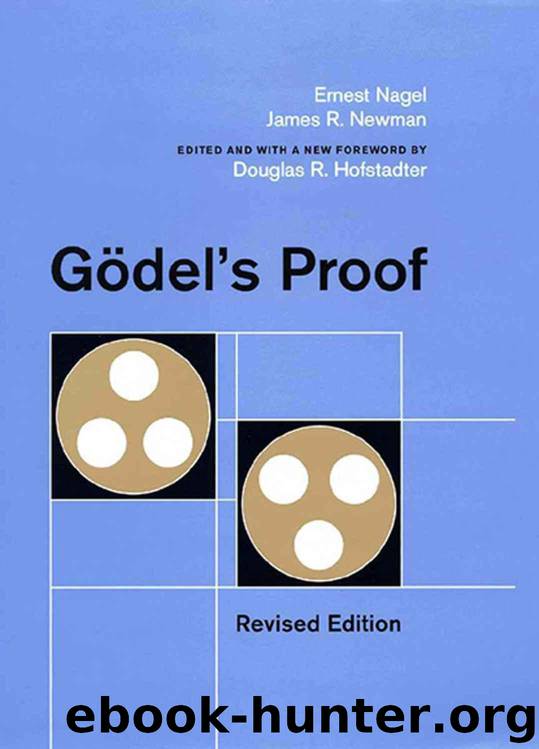Godel's Proof by Nagel Ernest & James R. Newman & Douglas R. Hofstadter

Author:Nagel, Ernest & James R. Newman & Douglas R. Hofstadter [Nagel, Ernest]
Language: eng
Format: mobi
Publisher: NYU Press academic
Published: 2001-09-30T16:00:00+00:00
VII
Gödel’s Proofs
Gödel’s paper is difficult. Forty-six preliminary definitions, together with several important preliminary propositions, must be mastered before the main results are reached. We shall take a much easier road; nevertheless, it should afford the reader glimpses of the ascent and of the crowning structure.
A Gödel numbering
Gödel described a formalized calculus, which we shall call “PM,” within which all the customary arithmetical notations can be expressed and familiar arithmetical relations established.15 The formulas of the calculus are constructed out of a class of elementary signs, which constitute the fundamental vocabulary. A set of primitive formulas (or axioms) are the underpinning, and the theorems of the calculus are formulas derivable from the axioms with the help of a carefully enumerated set of Transformation Rules (or rules of inference).
Gödel first showed that it is possible to assign a unique number to each elementary sign, each formula (or sequence of signs), and each proof (or finite sequence of formulas). This number, which serves as a distinctive tag or label, is called the “Gödel number” of the sign, formula, or proof.16
The elementary signs belonging to the fundamental vocabulary are of two kinds: the constant signs and the variables. We shall assume that there are exactly twelve constant signs,17 to which the integers from 1 to 12 are attached as Gödel numbers. Most of these signs are already known to the reader: ‘~’ (short for ‘not’); ‘V’ (short for ‘or’); ‘⊃’ (short for ‘if . . . then . . .’); ‘=’ (short for ‘equals’); ‘0’ (the numeral representing the number zero); ‘+’ (short for ‘plus’); ‘×’ (short for ‘times’); and three signs of punctuation, namely, the left parenthesis ‘(’, the right parenthesis ‘)’, and the comma ‘,’. In addition, two other signs will be used: the inverted letter ‘E’, which may be read as ‘there is’, and which occurs in so-called “existential quantifiers”; and the lowercase letter ‘s’, which is prefixed to numerical expressions to designate the immediate successor of a number.
To illustrate: the formula ‘(∃x) (x = s0)’ may be read ‘There is an x such that x is the immediate successor of zero’. The table below displays the twelve constant signs, states the Gödel number associated with each one, and indicates the usual meaning of the sign.
Download
This site does not store any files on its server. We only index and link to content provided by other sites. Please contact the content providers to delete copyright contents if any and email us, we'll remove relevant links or contents immediately.
| Algebra | Calculus |
| Combinatorics | Discrete Mathematics |
| Finite Mathematics | Fractals |
| Functional Analysis | Group Theory |
| Logic | Number Theory |
| Set Theory |
Modelling of Convective Heat and Mass Transfer in Rotating Flows by Igor V. Shevchuk(6392)
Weapons of Math Destruction by Cathy O'Neil(6155)
Factfulness: Ten Reasons We're Wrong About the World – and Why Things Are Better Than You Think by Hans Rosling(4696)
Descartes' Error by Antonio Damasio(3232)
A Mind For Numbers: How to Excel at Math and Science (Even If You Flunked Algebra) by Barbara Oakley(3224)
Factfulness_Ten Reasons We're Wrong About the World_and Why Things Are Better Than You Think by Hans Rosling(3201)
TCP IP by Todd Lammle(3137)
Fooled by Randomness: The Hidden Role of Chance in Life and in the Markets by Nassim Nicholas Taleb(3050)
Applied Predictive Modeling by Max Kuhn & Kjell Johnson(3020)
The Tyranny of Metrics by Jerry Z. Muller(3008)
The Book of Numbers by Peter Bentley(2913)
The Great Unknown by Marcus du Sautoy(2651)
Once Upon an Algorithm by Martin Erwig(2602)
Easy Algebra Step-by-Step by Sandra Luna McCune(2587)
Lady Luck by Kristen Ashley(2537)
Practical Guide To Principal Component Methods in R (Multivariate Analysis Book 2) by Alboukadel Kassambara(2497)
Police Exams Prep 2018-2019 by Kaplan Test Prep(2489)
All Things Reconsidered by Bill Thompson III(2358)
Linear Time-Invariant Systems, Behaviors and Modules by Ulrich Oberst & Martin Scheicher & Ingrid Scheicher(2335)
